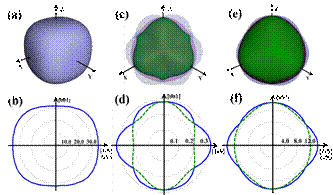| Elastic Property of a Dense Inorganic-Organic Framework |
| From: PublishDate:2017-06-16 Hits: |
Porous hybrid inorganic-organic framework materials have been studied intensively in chemistry, physics, and material science due to their potential applications in carbon capture, gas separation, catalysis, drug delivery and sensoring. Recently, considerable efforts have been dedicated to investigating dense inorganic-organic frameworks since they show fascinating physical properties, such as semiconductivity, ferromagnetism, ferroelectricity and multiferroicity, which are dominated by traditional inorganic materials. For example, a family of dense hybrid perovskites, [AmineH+][MX3] (Amine = methylammonium or formadinium, M = Sn or Pb, X = Cl, Br or I), have been reported to function as light harvesters in solid state sensitised solar cell devices with impressive efficiency values about 20%. Another dense framework, [NH4][Zn(HCOO)3] has been shown to be a striking multifunctional material with combined ferroelectricity, negative thermal expansion and negative linear compressibility. However, there is a major lack of knowledge about their fundamental mechanical properties, which apparently could delay the development of driving these promising materials towards practical applications. In contrast, the mechanical properties of many porous frameworks (i.e. MOF-5, ZIF-8) have been extensively studied, and significant information about their elasticity, plasticity, and structural stability upon stress have been reported. To attract more attention on dense hybrid frameworks and motivate more efforts dedicated to this important area, herein we focus our interest in the mechanical properties of a dense framework, [DABCOH22+][K(ClO4)3] . An ABX3-type cubic dense framework [DABCOH22+][K(ClO4)3](DABCOH22+= diazabicyclo[2.2.2]octane-1,4-diium) has been prepared. The high pressure elastic property has been systematically studied by high pressure synchrotron X-ray powder diffraction and DFT calculation. The obtained bulk modulus is 30(1) GPa, and the corresponding axial compressibility is 7.6(4)×10-3 GPa-1. Moreover, the bulk modulus 30(1) GPa is in reasonable agreement with the result derived from the DFT calculation. These results indicate that the framework is less compressible than a great deal of porous materials (~5-30 GPa). Further extensive DFT calculations of elastic tensors give a full mapping of the Young’s modulus, shear modulus and Poisson’s ratios of [DABCOH22+][K(ClO4)3], which are 31.6–36.6 GPa, 12.3–14.6 GPa and 0.2–0.32, respectively. The Young’s and shear modulus of the framework are larger than those from MOF-5 and CH3NH3PbI3, and are an order of magnitude higher than those from ZIF-8. In addition, the range of Poisson’s ratios is significantly narrower than those from MOF-5 (0.09-0.8) and ZIF-8 (0.33-0.57), implying its more isotropic feature in response to biaxial stretch and compression. This study has given one more example about the better understanding of mechanical properties of dense hybrid framework materials. And the high mechanical strength of these frameworks indicates that their more robust nature against stress could be an advantage in the future industrial manufacturing and processing.
|
|
|
| Chinese
- Metal-free efficient photocatalyst for stable visible water splitting——Top ten major scientific progresses in China in 2015
- The nano-resolution imaging platform was awarded the first rate prize of Beijing Science and Technology in 2014
- Beamline 1W1 of BSRF started to runoperate in the couplingparasitic mode of BEPCII
- Synthesis of High Performance Polymer Materials for Field Effect-Transistors
- Surfactant molecular aggregates in green solvents
- GIXRD has played an important role in the characterization of organic thin-film transistors
Science Highlights
Home /
Copyright © 2011 - 2012 Beijing Synchrotron Radiation Facility


